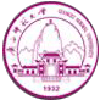Guilin SightseeingVisit Guilin's Landmarks and Immerse in Chinese CultureThe scenery of Guilin has been called the finest under heaven. Situated in the northeast of Guangxi Zhuang Autonomous Region, Guilin is South China's shining pearl, with verdant mountains, elegant waters, magnificent crags, and fantastic caverns. As a centre for tourism, Guilin boasts magnificent natural beauty and many precious cultural relics. Guilin is relatively free of air pollution. What makes it special is its proximity to many picturesque limestone mountains and formations. It is also well worth booking a tour to the terraced rice fields about an hour outside of the city. A boat ride around the main attractions is now available at night. Everything is lit up by neon lights, and the boat traverses the waterways joining the main attractions.
The park is endowed with elegant mountains, clear water, miraculous stone forest, deep and serene valleys, plentiful animals and plants and valued cultural relics. It has been popular since the Sui (581-618) and Tang (618-907) Dynasties. The main sights contain Flower Bridge, Putuo Mountain, Seven Stars Cave, Camel Hill, Crescent Hill, Guihai Stele Forest and Light of China Square on which you can find more information as follows: Flower Bridge Putuo Mountain Putuo Mountain is the main body of the park. It abounds with caves and pavilions. At the southwestern foot of the mountain lies the natural air condition Xuanfeng Cave. At halfway up the mountain is the Putuo Jingshe (a two-storied pavilion). At the west belly of the mountain is the renowned Seven Stars Cave, which is also called Qixia Cave or Bixu Cave. With the multifarious stalactites, stalagmites and stone pillars formed by the dissolved limestone, the cave was called 'Residence of the Immortals'. Turning right and go on climbing the mountain, are the Tomb of the Three Generals and the Tombs of 800 Heroes. On the top of the mountain, there are Putuo Stone Forest, Xuanwu Pavilion and Zhaixing Pavilion. In addition, there are numerous valuable tablets on the mountain. Camel Hill
A hermit in the Ming Dynasty once lived here and grew large numbers of plum trees. In spring, the full-blown plum blossom, together with the rays of the sunrises or sunsets drapes the hill with a gorgeous glow. This is one of the Ten Scenes of Guilin. Around the hill are bonsai gardens, a zoo and teahouses. Camel Hill is a wow of a sight. Being so like a camel, it is hard to believe that it is an entirely natural formation. Crescent Hill Walking into the park, there is Crescent Hill on the right. The hill was given its name due to the crescent-shaped stone at its belly. A notable feature of this hill is the 200 calligraphy carvings in the caves, located on the hill. These carvings are said to be the work of important and talented calligraphers of the Tang, Ming and Qing Dynasties. On top of the hill, pavilions, kiosks and towers line the path, each offering excellent views of the Xiao Dongjiang River. Standing from Crescent Hill, the sights of Guilin City can be seen. At the southwestern foot, there is Guihai Stele Forrest, which consists of Longyin Cave, Longyin Rock. The Guihai Stele Forrest has more than 100 tablets, referring to politics, economy, culture and military affairs in the form of poems, posies, couplets and images. The characters in the tablets are inscribed in regular script, cursive script, seal characters and clerical script. Seven StarsCave Seven Stars Cave a further two-minute walk upon leaving Putuo Jingshe leads to Seven Stars Cave. The Seven -StarCave is a must see. This is the most famous of the scenery in Guilin. Eroded by water over thousands of years, the cave is a wonderland of stalactites, stone pillars and rock formations resulting from carbonate deposition. All year, the temperature within the cave remains at a constant 20 degrees Celsius and has been a tourist attraction since the Tang Dynasty. However, for despite its splendor, the Seven Stars Cave is overshadowed by the awe-inspiring Reed Flute Cave to be found five kilometers northwest of the city. Guihai Stele Forest
Light of China Square The Light of China Square is between Putuo Mountain and Crescent Mountain. It boasts of two craftworks, one of which is the stone carving murals and the other is Shi Ji Bao Ding, the precious Ding of the century. Shi Ji Bao Ding, a four-legged Ding at a height of 4.6 meters (15 feet), symbolizes that the country flourishes and people live in peace.
Li River, Taohua River, Shahu Lake, Ronghu Lake, Guihu Lake and the newly dug Mulong Lake are all interconnected. The waterway transportation makes up of Guilin's central round-the-city water system, called "Two Rivers and Four Lakes". More than 1000 years ago Guilin formed a complete moat river system. Tour and Recreation on water had been very much in a fashion in the Tang and Song Dynasties, and remains so in present day.
Li River is a major component of Guilin scenery. As it sparkles in the sunlight the river meanders through lush mountains like a liquid jade belt. Guilin's scenery is unique both to China and to the rest of the world. Emerging from a flat green plane laced with rivers and lakes the Karst formations are steep, rounded towers of stone which stand in a line like battlements. This bizarre range of peaks has caused Guilin to be immortalized in Chinese painting and poetry. The Li River cruise from Guilin to Yangshuo is the centerpiece of any trip to northeastern Guangxi Province. The Li River of Guilin tour begins at Cat Mountains in Xing'an County and flows through Guilin, Yangshuo, and enters into West River in Wuzhou, totaling 437 kilometers. The river trip is over eighty kilometers (52 miles) long and takes about seven to eight hours to enjoy the eye-feasting grotesque peaks and the landscape appears to be a beautiful sketch. Water buffalo patrol the fields, peasants reap rice paddies, school kids and fisherman float by on bamboo rafts. With its breathtaking scenery and taste of a life far removed from the concrete metropolis, the scenery along the Li River become one of China's top tourist destinations. It is a Chinese tradition to divide the long trip into sections and give each peak an imaginative name. Although some take some imagination to see what it is like, listening to a tour guide's legendary stories behind them is a delightful experience. Most are mystical fairy and love stories.
The whole hill looks similar to a huge elephant stretching its trunk drinking water by the Li River. It is the masterpiece of Karst landscape, composed of pure limestone deposited on seabed 360 million years ago. Between the trunk and the legs of the "Elephant Trunk Hill" is a cave in the shape of a full moon, penetrating the hill from side to side. People named it "Moon Over Water Cave". When the waters wave and the moonlight gleam, the scene is exceedingly enchanting. On the walls in and around this cave, over 70 inscriptions from the Tang and Song Dynasties were found, praising the beauty of hills and waters nearby.
Perching on the northern bank of Li River, the ancient town of Daxu is kept in its antique style from the Ming Dynasty (1368-1644). A flagging street, lined with old residences, shops and stalls, runs two kilometers along the river bank through the town. Some well-preserved residences hidden behind the street door may surprises visitors when they occasionally explore further into a shop. These were quarters for businessmen in past times. When in Daxu Town, visitors should try some of the various dumping snacks sold in the stalls or peddle cars along the street. Visitors may be surprised with both its good taste and cheap price. People in the town are very kind to tourists. Further to south, there is a single-arched bridge in the town named the Longevity Bridge. The town is really a sight off-the-beaten track. Opposite the town on the other side of the river, a millstone-like rock with the running waters creates the scene of Grinding Grain.
A crown-like cliff earns the hill its name. What makes the hill a worthy stop for both river cruise tourists and those arriving from Guilin City by bus tour is its twelve kilometer long water-eroded cave. It is a wonderland of various stalactite, stone pillars and rock formations in the cave. Since it opening to tourists in 1995, illuminating lights, sound control tour guide system and escalators have been set-up in the scenic area and sightseeing cars and boats enable visitors to tour inside the cave. This site as an all-round tourist area includes cave visiting, country sightseeing and ethnic minority exploration. It is estimated to become an important excursion site along the Li River.
Not very far from the Crown Cave on the western bank, a huge rock descends into the river and cuts off a footpath by the water edge. Villagers have to take a ferry to reach the other side and continue the way. So, this spot gets its name Half-Side Ferry (for usually ferry means to transport people by boat across a body of water and reach the opposite bank). From Yangdi to Xingpin Down stream from Yangdi to Xingpin, the river passes an endless procession of distinct peaks and bamboo groves and the stunning landscape. This part is the highlight of the cruise. Pinnacled peaks pop up and surprise visitors at each bend of the river. Water buffalos patrol on the fields; ducks paddle in the waters; peasants reap paddies in front of village houses; fishermen use the cormorants to catch the fish and return them to the boat and kids go home singing songs. All these create an idyllic and beautiful scene of the life removed from concrete cities. A reputed attraction is Mural Hill, a 100 meter high cliff face, which has been weathered and has stratified rock surface in various shades of colors. It is storied that the colors present nine horses and a person who can identify them out is considered smart. Legendary stories are given to hill rocks and peaks and it is a delightful experience to appreciate the stunning landscape while listening to tour guide's interpretation of the stories behind it.
The Reed Flute Cave is named after a kind of reed growing in the neighborhood, which can be made into melodious flute. Inside this water-eroded cave is a spectacular world of various enchanting stalagmites, stone pillars, stele, stone curtains and stone flowers. Illuminated by colored lighting, the fantastic spectacle is found in many variations along this 240 meter long cave. Tourists enter the cave and then take a U-shaped sight-seeing route to see different spots, whereupon they exit it from another cave quite near the entrance one.
It is a splendid Karst cave with a myriad of stalactites and stalagmites of all strange shapes: some like lions, some like frogs and some like a crystal palace. What impresses visitors most in Guilin are the stone curtains, which not only boast fantastic forms but resonant sounds. When struck, some give a booming sound similar to a drum; others produce a ring which sounds like a piano. The forms and sounds here make the cave "the art palace of the nature". First officially opened to the public in 1962, the cave now is a main attraction in Guilin. It is a fantastic place where imagination will fly with strong wings. It is of course a must for all the visitors to Guilin.
With half of the hill stretching into the river, the 120 meters
long, 60 meters wide and 213 meters high hill, stands on its
own to the northeast of the city, on the west bank of the Li
River. The waves of the river are turned back when they meet
the stone blocks of the hill, hence the name "wave-curbing
hill". On the southern slope of the hill is Pearl Returning
Cave. At the foot of the hill is the famous Pearl Returning Cave, which is composed of many side-caves, linked like a labyrinth. A several-meter stalactite column, thick on top and tapering downwards, hangs all the way from the ceiling the ground. No visitors will see it without amazement. Since the space between the column and the ground seems to be the result of a sword cut it is named Sword Testing Stone.
Half way up the hill, a cave penetrates from north to south.
With two
Solitary
Beauty Peak (Duxiu Peak), towering
from the ground with an elevation of 216 meters, is known
as "Sky Supporting Pillar in the South". This is the
oldest place of interest in Guilin. Solitary Beauty
Peak stands in solitary grace at the center of the ancient
Mansion of Prince Jingjiang, a noble family in the Ming
Dynasty. During the Southern Dynasty (420-589), some
1500 years ago, Yan Yanzhi, governor of Guilin, wrote
the line: "none can surpass this solitary peak in
beauty"; hence the name Solitary Beauty Peak.
In ancient times about 2,000 years ago, the Ling Canal was an irrigation canal. The canal was once an important means of transports serving the region before railways and roads were constructed. Now this canal still serves it purposes by irrigating about 2700 hectare of agricultural lands. Looking at the way that the canal is constructed brings to
mind the wisdom achieved by the ancient peoples in the engineering
fields employed in the construction of dam and embankment.
Dams were mainly made of woods and stones. Studies revealed
that logs were first pile and stacks up in the water to stabilize
the ground. Thereafter, slabs of stone were placed against
the logs to form an embankment. Each stone slab has a groove
cut into it for an iron bar to slot through it to joint up
each slab together to form a continuous embankment, which stretches
for five hundred meters in length.
These tombs are well preserved, the site covers an area over 100 square kilometers with more than scattering 300 tombs. In front of each tomb stands Huabiao (ornamental column erected in front of palace, tombs), official stone statues, various animals such as tigers, lions and unicorns. These stone works were exquisitely made, primitively simple and stately.
XishanPark is the second largest park in Guilin, which is comprised of Xi Hill and Yin Hill. This used to be a shrine of Buddhism and one of the five Buddha Temples in the south.
Yu Hill Park is the cradle of Guilin history. Legend has it that one of the ancestor of Chinese nationality, Shun Yu visited here and Qin (B.C.220-B.C.206) people set up temple to memorize him. In the past 2000 years, numerous people came here to offer up sacrifices; hence this park has a strong influence of Confucianism.
Yuzi Paradise is the largest sculpture park in China. One hundred and fourteen artists from no less than forty-seven different countries have contributed to this magnificent symphony of nature and humanity. Located 30 kilometers (18.6 miles) from Guilin, this park is a harmonious blend of life and art. Visitors are given the opportunity to make clay wares under construction. In addition to the above mentioned parks, NanxiPark in the south of the city and Chuanshan Park in the southern suburbs each has their own beauty and attractions.
Bear and TigerPark is the largest wild animal center. Four breeds of tigers facing extinction can be seen there. Over three hundred tigers, four hundred bears, and a hundred lions will give you a fresh idea about the survival needs of such wild animals. Also there are animal performances, which will surely excite kids and adults alike.
The Guilin Ocean World is on the south of NanxiPark. Here many aquaria containing some thousand or so varieties of fish can be seen. The center has an observation area, performance area, tropical forest and waterfall area, a touching area, underwater tunnel, sea area and so on. Marine treasures like giant hundreds-year old salamander, lungfish, clownfish, sea flowers, nautilus, living coral and sharks from around the world can all be seen here.
Yangshuo, a very picturesque village downstream of Guilin, is well worth visiting. There are also boats going to Yangshou. Travelers can take a river trip down the Li River on tour boats. From Guilin to Yangshuo, the river winds through some truly spectacular limestone formations and a slow boat trip there and back, with a stop in Yangshuo, will take a whole day. |

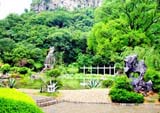 Seven-StarPark is
located on the bank of Li River crossed by Xiaodong River,
at the end of Jiefang East Road, and approximately one and
a half kilometer from the downtown area of Guilin. Covering
an area of more than 120 hectares (297 acres), this is the
largest and most popular park in Guilin with the longest history.
Seven-StarPark is
located on the bank of Li River crossed by Xiaodong River,
at the end of Jiefang East Road, and approximately one and
a half kilometer from the downtown area of Guilin. Covering
an area of more than 120 hectares (297 acres), this is the
largest and most popular park in Guilin with the longest history.  Built in the Song Dynasty (960-1279), the Flower Bridge is
the oldest bridge in Guilin. Every spring and summer, it is
set off with blooming flowers and the streams, hence the name
Flower Bridge. The larruping point of the bridge lies in the
arch's inverted reflection in water always looks like a full
moon. It never changes even though the quantity of water changes.
Built in the Song Dynasty (960-1279), the Flower Bridge is
the oldest bridge in Guilin. Every spring and summer, it is
set off with blooming flowers and the streams, hence the name
Flower Bridge. The larruping point of the bridge lies in the
arch's inverted reflection in water always looks like a full
moon. It never changes even though the quantity of water changes.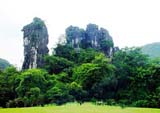 Camel Hill is another attraction of the the
Seven Stars Park. This limestone outcrop looks exactly like a
camel resting among the trees. The main entrance to the park is
over the Flower Bridge, an elegant arched structure dating from
the Song Dynasty that crosses the confluence of Xiaodongjiang
and Lingjian Stream that passes through the park.
Camel Hill is another attraction of the the
Seven Stars Park. This limestone outcrop looks exactly like a
camel resting among the trees. The main entrance to the park is
over the Flower Bridge, an elegant arched structure dating from
the Song Dynasty that crosses the confluence of Xiaodongjiang
and Lingjian Stream that passes through the park. 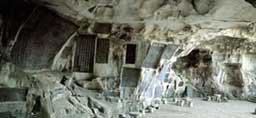 The
forest lies to the south of Yueya Hill. There are about 2,000
pieces of stone carvings and inscriptions in Guilin, of which
about 100 are in the Dragon Refuge Cave. In order to protect
historical relics, an exhibition hall has been built at the
entrance of the cave. Among the most famous and precious inscriptions
are "The Membership Roster of Yuan You Group", "Meizhi
on Five Miasmata", and "Eulogy to Five Gentlemen
by Huang Ting-jian". The exhibits have topics ranging
from politics to history, science and calligraphy.
The
forest lies to the south of Yueya Hill. There are about 2,000
pieces of stone carvings and inscriptions in Guilin, of which
about 100 are in the Dragon Refuge Cave. In order to protect
historical relics, an exhibition hall has been built at the
entrance of the cave. Among the most famous and precious inscriptions
are "The Membership Roster of Yuan You Group", "Meizhi
on Five Miasmata", and "Eulogy to Five Gentlemen
by Huang Ting-jian". The exhibits have topics ranging
from politics to history, science and calligraphy.
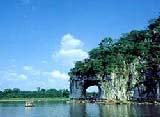 Xiangbishan,also called the Elephant Trunk
Hill, is situated majestically at the southeast of Guilin city
and west bank of Li River. It is the badge of Guilin city
and the landmark of Guilin landscape. Originally named "Li
Hill", "Yi Hill" and "Chenshui Hill",
the hill has a history of 3.6 hundred million years.
Xiangbishan,also called the Elephant Trunk
Hill, is situated majestically at the southeast of Guilin city
and west bank of Li River. It is the badge of Guilin city
and the landmark of Guilin landscape. Originally named "Li
Hill", "Yi Hill" and "Chenshui Hill",
the hill has a history of 3.6 hundred million years. 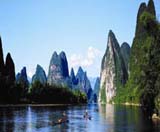 Halfway up the hill lays another cave, which goes through
the hill and serves as the eyes of the elephant, through which
visitors can overlook the beautiful scene of Guilin city.
On top of the hill stands a pagoda named Puxian Pagoda. Built
in the Ming dynasty (1368-1644), it looks like the handle of
a sword. In and out of the cave are many carvings and inscriptions,
the most well-known of which is a poem by Lu You, one of the
four great poets of the Southern Song Dynasty (1127-1279).
Halfway up the hill lays another cave, which goes through
the hill and serves as the eyes of the elephant, through which
visitors can overlook the beautiful scene of Guilin city.
On top of the hill stands a pagoda named Puxian Pagoda. Built
in the Ming dynasty (1368-1644), it looks like the handle of
a sword. In and out of the cave are many carvings and inscriptions,
the most well-known of which is a poem by Lu You, one of the
four great poets of the Southern Song Dynasty (1127-1279).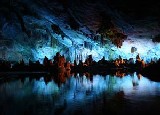 Reed
Flute Cave (Lu Di Yan) is at the foot of Guangming
Hill five kilometers (three miles) from downtown in northwest
suburb of Guilin. The Reed Flute Cave is a brilliant cave marked
on almost all travel itineraries.
Reed
Flute Cave (Lu Di Yan) is at the foot of Guangming
Hill five kilometers (three miles) from downtown in northwest
suburb of Guilin. The Reed Flute Cave is a brilliant cave marked
on almost all travel itineraries.  It is a Chinese habit to give each formation a legendary or
poetic name such as Crystal Palace, Virgin Forest, Flower and
Fruit Mountain and other interesting names. This wonderland
is referred to as Nature's Museum of Art. Some 70 inscriptions
on the cave wall are said to be travelogues and poems derived
from the Tang Dynasty, which made the cave a popular tourist
site at that time. A park is built for the cave with zigzag
path, elegant pavilions, ponds, bridges, plants and other garden
structures.
It is a Chinese habit to give each formation a legendary or
poetic name such as Crystal Palace, Virgin Forest, Flower and
Fruit Mountain and other interesting names. This wonderland
is referred to as Nature's Museum of Art. Some 70 inscriptions
on the cave wall are said to be travelogues and poems derived
from the Tang Dynasty, which made the cave a popular tourist
site at that time. A park is built for the cave with zigzag
path, elegant pavilions, ponds, bridges, plants and other garden
structures. The
east of the cave curbs the river stream, causing the formation
of a deep pool, so the hill is named Fubo Hill (Wave-Curbing
Hill). Fubo Hill is famous for its six beauties:
hills, water, caves, stones, courts, and cultural relics.
The
east of the cave curbs the river stream, causing the formation
of a deep pool, so the hill is named Fubo Hill (Wave-Curbing
Hill). Fubo Hill is famous for its six beauties:
hills, water, caves, stones, courts, and cultural relics.  Located north of Guilin city by the Li River, the Folded Brocade
Hill is one of the three most famous hills in Guilin (the other
two are Fubo Hill and Elephant Trunk Hill). It consists of
Yuyue Hill, Siwang Hill (Looking In Four Direction Hill), Crane
Peak and Bright Moon Peak. The hill is so named because layers
and layers of multi-colored rocks one atop another like a great
pile of folded brocade. Four small hills, Yuyue Hill, Siwang
Hill (All Direction Looking Hill), Crane Peak and Bright Moon
Peak surround Diecai Hill.
Located north of Guilin city by the Li River, the Folded Brocade
Hill is one of the three most famous hills in Guilin (the other
two are Fubo Hill and Elephant Trunk Hill). It consists of
Yuyue Hill, Siwang Hill (Looking In Four Direction Hill), Crane
Peak and Bright Moon Peak. The hill is so named because layers
and layers of multi-colored rocks one atop another like a great
pile of folded brocade. Four small hills, Yuyue Hill, Siwang
Hill (All Direction Looking Hill), Crane Peak and Bright Moon
Peak surround Diecai Hill. 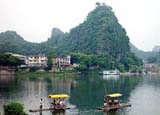 spacious mouths and a narrow middle, the cave takes
a shape of a calabash. The cave adopted its name for a cool
breeze continually blows in the cave all year round. It is
well-known for 90 Buddha images of the Tang and Song Dynasties.
After thousands of years' rain and wind, these images are still
vivid and life-like. On the top of the hill stands the cloud
catching Pavilion, which commands a panoramic view of the city
below.
spacious mouths and a narrow middle, the cave takes
a shape of a calabash. The cave adopted its name for a cool
breeze continually blows in the cave all year round. It is
well-known for 90 Buddha images of the Tang and Song Dynasties.
After thousands of years' rain and wind, these images are still
vivid and life-like. On the top of the hill stands the cloud
catching Pavilion, which commands a panoramic view of the city
below.  The
Tombs of Prince Jingjiang is a state cultural
relic. Located in an eastern suburb at the foot of Yao Mountain
in east suburb seven kilometers from Guilin, there is an important
imperial mausoleum historical site where eleven princes of
the Jingjiang Family during the Ming Dynasty (1368-1644) are
buried.
The
Tombs of Prince Jingjiang is a state cultural
relic. Located in an eastern suburb at the foot of Yao Mountain
in east suburb seven kilometers from Guilin, there is an important
imperial mausoleum historical site where eleven princes of
the Jingjiang Family during the Ming Dynasty (1368-1644) are
buried.  The Jingjiang Family is comprised of the descents of King
Jingjiang, the nephew of a Ming Emperor. During the earlier
Ming period, to strengthen the centralization of state power,
Ming Emperor Taizu (the first Ming emperor) designated his
24 sons as kings to administer different areas in China. King
Jingjiang got his title and built his palace at the foot of
Solitary Beauty Peak. The descendent kings chose this mausoleum
site as their burial place.
The Jingjiang Family is comprised of the descents of King
Jingjiang, the nephew of a Ming Emperor. During the earlier
Ming period, to strengthen the centralization of state power,
Ming Emperor Taizu (the first Ming emperor) designated his
24 sons as kings to administer different areas in China. King
Jingjiang got his title and built his palace at the foot of
Solitary Beauty Peak. The descendent kings chose this mausoleum
site as their burial place. Towering high up in the Shan Lake, the two towers, Golden Tower and Silver Tower,
are quite an eye-striking sights. The Golden Tower is a nine-storied architecture
of 41 meters high. Built with copper, it ranks as the highest tower as its
kind. The Silver Tower, 35 meters high, is decorated with colored glaze all
through. The two towers are linked by aquarium under the water. Bearing colorful
designs on the doors and windows, they look stately, yet graceful. During
the day, the breeze ripples across the lake and the two towers shine like diamonds.
Towering high up in the Shan Lake, the two towers, Golden Tower and Silver Tower,
are quite an eye-striking sights. The Golden Tower is a nine-storied architecture
of 41 meters high. Built with copper, it ranks as the highest tower as its
kind. The Silver Tower, 35 meters high, is decorated with colored glaze all
through. The two towers are linked by aquarium under the water. Bearing colorful
designs on the doors and windows, they look stately, yet graceful. During
the day, the breeze ripples across the lake and the two towers shine like diamonds.